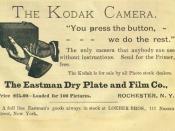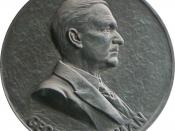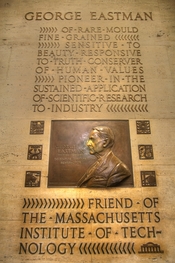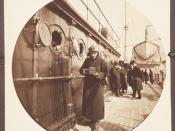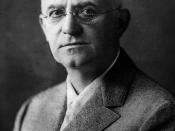George Eastman was born on July 12, 1854 in Waterville, New York, a town inhabited by only a few hundred people. George was the third child, first boy, born to George Washington Eastman and Maria Kilbourn and was born into a small, "one-story frame house⦠[which] was the only one of its type in the community, easily recognizable because of the diminutive colonial porch and the attic windows which appeared to be squeezed under the eaves" (5).
When George was six years old, his family left Waterville and moved to a city in the Genesee Valley; unfortunately, however, his father died two years later. When he reached the age of fourteen, George made the decision to leave high school in order to support his mother and sisters because of the fear of poverty. His first job was as a messenger boy at a local insurance company and later became an office boy for a different insurance firm.
Yet he was still not able to make the proper amount of money to support his family. As a result, he decided to study accounting at home in hopes of finding a better job with higher pay. Finally, in 1874, he became a junior clerk and tripled his salary.
George became intrigued with photography when he was twenty-four years of age but found the process of it awkward; however he managed to find a way to make this process simpler and, in result, created a business out of it. He was a very successful business man and has "helped to bring photography to the mainstream" (58). He spent most of his life working at this company and in 1888 he registered the trademark "Kodak" which is still commonly used in today's society. George never had a wife or children to go home to; instead, he dedicated his life to his passion.
In 1930, he began to have very intense pains due to an irreversible spinal disease. George became very depressed in his final two years, just as his mother had when she was suffering from the same disease. On March 14, 1932, Eastman ended his own life.
The book George Eastman: Founder of Kodak and the Photography Business was written by Carl W. Ackerman. George was recommended to write an autobiography by an economist from Columbia University. However, he could never seem to find the proper amount of time to write as he was already occupied with many other projects. This led him to turn to Carl W. Ackerman for his assistance in writing his biography. Because this study was written during George Eastman's lifetime, Ackerman was able to interview those who knew and worked with George in order to assess him in the different aspects of his life.
George Eastman's detailed ancestry and youth is featured in this book. It goes all the way back to a more brief description of his grandparents' lives and how they had immigrated to the USA from England in the 1600's. This particular description works up to George's father's life and the fact that he went to Rochester, founding Eastman's Commercial College.
This biography lays out detailed information regarding George Eastman's fascinating inventions, as well as his interests and management skills. He has become known as one of America's finest entrepreneurs and innovators as his invention transformed the art of photography and influenced the age of film making. Contents from a myriad of letters, written by George himself as well as his friends, family, employees, and other business associates, are also previewed throughout this book as well as some of Eastman's notes and records regarding his numerous inventions. By inspecting these particular letters and notes, evident information can be found on exactly how he handled different matters as well as the styles which he used for management purposes.
Overall, the book brings forth much accurate information which is used to examine the history, success, and business ethics of this particular entrepreneur.
George Eastman is a businessman, inventor, and a philanthropist. In 1878, he established a new passion for photography but found the process to be quite a nuisance. This inspired him to develop a quicker and easier way to take photos: roll film. By1880, he had begun his own photography business which would process people's film, make prints, and sell rolls of film.
Settling on the right name for his company was crucial for Eastman as he spent a myriad of hours thinking of one. He came up with three principle concepts for the name: 1) it must be short and easily remembered, 2) it must not have the chance of being mispronounced, and 3) it must not represent or be associated with anything but itself. George took a liking to the letter "K"; he said that "it seems a strong, incisive sort of letter" (102). Because of this conviction, he thought it necessary to have his company's name start and end with a "K". After much thought and provocation, he finally came up with the trademark "Kodak". However, George knew that it would take more than a name to make a successful business.
The power of advertising was another strong belief of Eastman's; therefore, he put much effort into creating flyers which would be sent out with the daily newspapers. Within a year, he had already become famous for his slogan "You press the button, we do the rest." George was indeed motivated to have his brand known worldwide as he could not let this opportunity pass by.
Despite his great ethics in promoting the Eastman Kodak Company, George was not very well liked by his employees. He ran a tight ship and was well known for his dirty mouth. "He placed his office near the women's bathroom in order to monitor the frequency with which his female employees took bathroom breaks. He had specific instructions for the way in which janitors were to use their brooms. So, too, did he want his pencils to be sharpened in a specific way by his office clerks" (137). On the other hand, Eastman made sure that his employees had a secure future, by creating superior retirement packages and life insurance plans, in hopes of having his employees return the favour by helping to insure the company's success.
Eastman was a man who wasn't afraid to take a risk; in fact, his whole carrier was based on a risk. George didn't know anything about photography before it became his passion. He went "from having never taken a picture to starting up a company that focused only on that" (98). There were five factors which helped him reach the top of the corporate ladder: inexperience, branding, innovation, leadership, and strength. Firstly, since he had no knowledge of cameras, it was his guiltless optimism that let him envision the impossible. Next, Eastman was very aware of the fact that finding the perfect name for his company was a crucial part of the branding formulae. He also made a point to make sure that his products were able to fit into the wider market. Despite his lack of favour as a boss, Eastman made sure to stay loyal to his employees by giving them health benefits and wage dividends. Lastly, George came across many obstacles throughout his career and never gave up the strength to work through the problem.
Eastman once said, "What we do during our working hours determines what we have; what we do in our leisure hours determines what we are" (264). Being a very successful man at work, George must have had a lot of pride. He was very persistent in everything he did; giving up was not an option. Many of his ethics were and still are a very important part of creating a flourishing company. For example, he spent a large amount of effort in preparing his trademark as well as developing creative advertisements in order to make sure the world knew he was there to assist them. Although Eastman was kind enough to supply his employees with benefits, people often will not work for an unpleasant person. In his time there might not have been a lot of competition and therefore not many other places for his employees to leave to; however, in today's society crudeness will not always be accepted in a work place.
When reading George Eastman: Founder of Kodak and the Photography Business by Carl W. Ackerman, I found the text to be fairly straightforward and unproblematic. The reading was very coherent and transitioned well from one chapter to the next. Each chapter was placed in chronological order which made it uncomplicated in the sense that there was no need to look back and review what, exactly, is being said. Not only was it coherent, but the language was comprehendible. I had no difficulty understanding what the vocabulary which the author used in order to explain about George and his business. Also, all of the information seemed very accurate since George Eastman was still alive during the time which the author wrote this biography.
I found this read to be quite appealing and motivating as to how someone could take something that he barely knew anything about and made a career out of it. This ability to take risks is quite inspiring to those who are dreaming to, one day, start a business of their own. I would like to recommend this book to anyone who is eager to be an entrepreneur as it will encourage them to take chances in order to make the best out of an opportunity. Ackerman was very successful in capturing Eastman's life in a way which can help others to understand the, often overlooked, details which contribute to running a successful company.
Although the risk taking factor of this book was the most important thing that I got out of it, it was also good to see how seriously Eastman took branding, advertisement, and loyalty to his employees. I often become impatient in many situations and wonder if I would be able to concentrate on a name for my own company as hard has George had for his; however, after reading this book I can see the importance in doing so. Also, I found it interesting how he made such an effort to make sure his employees were secure with their benefit plans and wage dispenses. There are many details which this book has covered that raise my awareness and make me motivated to hopefully become something great. I can only hope that others will find the same appeal from this book so that they may do greater things.
Ackerman, Carl W. George Eastman. Beard Book, 1930.
